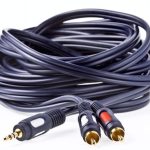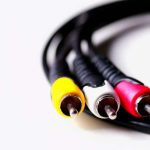Electrical wire is a type of wire used in transmitting electric current from a socket or any other electric power source to a device or for mains power wiring. On the other wire, speaker wire is a type of wire used in transmitting sound signals from a receiver or amplifier to a speaker. Let’s discuss each type of these wires and whether they’re similar or different.
Electrical Wire
Electrical wire is either made of aluminum or copper. It comes as either stranded wire or solid wire. Stranded wire comprises of several smaller strands of wire woven or wound together to form a thicker wire whereas solid electrical wire is a single, sturdy piece of wire. Electrical wire is usually insulated to prevent short circuit and shock. There’re several types of electrical wire available today. These wires include:
Nonmetallic Cable
Nonmetallic (NM) cable is a type of electric wire used in interior wiring. NM cable comes with a flat type of insulation. It’s usually run along floor cavities and through walls. This wire runs from the mains connection point to the wall outlets and lighting fixtures. It comes in gauges 6 to 14, each suitable for a certain ampere circuit. The smaller the gauge number, the thicker the wire and the larger the ampere range it can carry. Typically, a 6 gauge NM cable can carry a load of 55 amperes whereas a 14 gauge can carry a load of 15 amperes. Besides, NM cables come with color-coded insulation for indicating the wire gauge. The cable comprises of a hot insulated wire, neutral insulated wire, and a bare earth/ground wire. The three wires are then insulated by another outer plastic tubing.
Also Read: 14 vs 16 Gauge Speaker Wire- Is There Any Difference?
Underground Feeder Cable
Underground feeder (UF) cable is a type of nonmetallic cable ideal for use in wiring through wet locations. Thus, it’s ideal for underground wiring. It’s commonly used in wiring outdoor light fixtures or wiring between buildings through an underground piping. This wire comprises of three interior wires, including an insulated hot wire, insulated neutral, and bare earth wire. The three wires are then insulated by an outer plastic covering just like with NM cables.
THWN and THHN Electric Wire
These two types of electrical wire are used for high-voltage wiring through conduit. They comprise of at least two insulated wires. The wires are enclosed in an outer plastic sheathing. Each insulation is color-coded. Besides, these cables are protected by a plastic or metallic tubing. They’re typically used for connecting high current appliances such as water heaters and garbage disposers. In this type of electrical wire, T represents thermoplastic, H represents heat-resistant, HH represents high heat resistance, W represents wet locations, and N represents nylon-coating.
Low Voltage Wire
This is a type of electrical wire used in wiring low-voltage circuits, especially those below 50 vols. They’re ideal for wiring appliances such as sprinklers, bells, speaker power, thermostats, lights, and such other appliances. They are insulated and mainly come as a twisted pair. One of the wires is a hot shielded cable and the other is a neutral shielded cable. Although shock is rare with low voltage, they’re shielded to prevent short circuit.
Coaxial Cable
Coaxial cable is another type of electrical wire that comprises of a shielded solid wire surrounded by a bare braided wire. The two wires are then shielded by an exterior cable. This type of cable is typically used for connecting satellite dishes and aerials to decoders or TV sets. It’s typically round in shape. Coaxial cables carry extremely low voltage and hardly cause any shock.
Phone/data Cable
Another type of electrical wire is phone/data cable. These are a type of electrical wire used for internet and landline telephone connections. A typical internet cable comprises of eight wires and each of the wire is shielded and color-coded. All the eight wires are then shielded by an outer plastic covering. They carry low voltage and don’t cause any electric shock.
Speaker Wire
Speaker wire is a type of wire used for connecting speakers to a sound source such as an amplifier or receiver. Speaker wire is low voltage and doesn’t cause any shock. However, it’s insulated to prevent short circuit. Basically, speaker wire comes as stranded cables.
Speaker wire comes in two insulated cables and each insulation is color-coded. One of the insulated wire is for the left channel whereas the other insulated wire is for the right channel. The two insulated wires are then insulated with another outer insulation plastic or attached together.
Typically, speaker wire comes as copper wire, silver wire, copper clad aluminum, or oxygen-free copper wire. Copper wire is the most commonly used type of speaker wire. It’s affordable and low in resistance. However, it’s prone to oxidation. Thus, it’s insulated to keep it protected from oxidation.
On the other hand, silver speaker wire is the best type of wire for conducting sound signals. Besides, silver has low resistance. However, silver speaker wire is extremely expensive due to the high cost of mining the material.
Copper clad aluminum speaker wire comprises of an aluminum wire covered by a copper layer. This type of wire is affordable and light but has a higher resistance than copper wire. Oxygen-free copper speaker wire comprises of refined copper wire, whereby oxygen and other impurities are removed to prevent it from oxidizing. However, oxygen-free copper is more expensive than pure copper wire.
Typically, speaker wire comes in thicknesses of 12 to 18 gauge. Thicker speaker wire is ideal for longer runs of speaker wire and low impedance speaker systems. Thinner speaker wire is ideal for shorter wire runs and high impedance speaker systems.
Are electrical and speaker wire similar or different?
Now that you know the basics of electrical and speaker wire, it’s easier to know whether they’re similar or different. Typically, electrical wire and speaker wire are similar in terms of being good conductors of electricity. However, they’re different in several ways. For instance, speaker wire comes in the form of stranded wire whereas electrical wire comes as both stranded and solid wire. Also, speaker wire is only ideal for handling extremely low voltage current whereas electrical wire carries both high and low voltage depending on the type of electrical wire. Another difference is that speaker wire is only used for a single application, which is connecting speakers to a sound source. On the other hand, different types of electrical wire have different applications.
Conclusion
As you can see, electrical wire and speaker wire share minimal similarities and have several differences. You should always use the right type of wire depending on the application to avoid damaging your appliances or causing electric hazards. Thus, make sure you’re using the right wire gauge for each application.
Michael Evanchuk is a San Francisco-based sound engineer with 20 years’ experience installing, troubleshooting, and repairing commercial, automotive, and household sound equipment. Evanchuk owns an auto stereo center, where he offers highly competitive car audio installation and repair services. He has written dozens of articles on different sound engineering topics, all of which have been published in leading journals, blogs, and websites.





